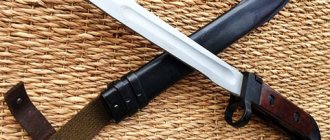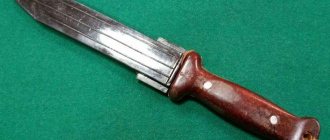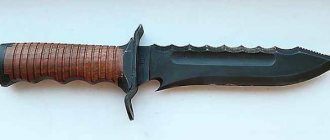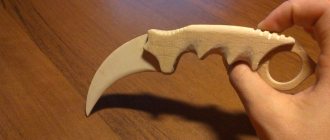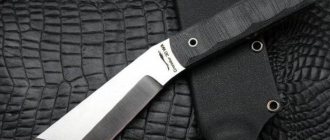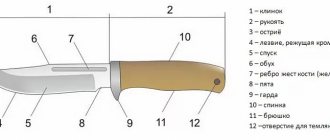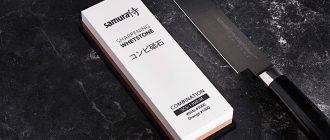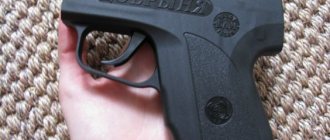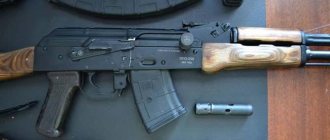What is more important for a hunter - a knife or a gun? Most likely, many will answer that it is a gun. Well, okay, so you got an elk or a wild boar, and then what? Will you put him on your back and go home, and then let your wife butcher him? - such an action would be worthy of being captured in a painting - “The last day of a hunter or a bad hunter is a problem in the family.” But, perhaps, let’s leave this humorous note and look into this issue seriously.
In fact, not a single hunter can give an exact answer what is more important for him - a knife or a gun, since without these two attributes hunting as such is not possible. Here I would like to immediately note that we are talking about real hunters, and not about those individuals who are brought to shoot the animal, and then also butcher it for them. It’s dangerous to give such types a knife in their hands; they’ll cut themselves again. But for a real hunter, a knife is not just an object, it is a friend and helper, starting from kitchen and household work in the camp, ending with harvesting (finishing off) and cutting up the hunted animal.
What is a hunting knife
The simplest and most commonplace definition of a hunting knife is a knife used in hunting by a hunter for cutting game, skinning an animal carcass, preparing food, cleaning fish. You will also need a hunting knife for cutting branches, setting up a fireplace, preparing stakes, etc. It is possible that a knife will be needed for self-defense from a wounded animal.
As you can see, a hunting knife must perform a lot of tasks and, if possible, combine the properties of a tourist, kitchen, and partly combat knife.
What should a hunting knife be like: expert opinions
I am sure that there is no single image of the correct hunting knife. Obviously, a hunter's knife and a fisherman's knife are not the same thing and perform different tasks. Even a game hunter's knife may differ from a wild boar hunter's knife.
However, it is possible to formulate requirements that apply to all hunting knives:
- The steel of a hunting knife must be strong and at the same time flexible. Experts believe that the ideal knife should withstand the hunter's weight.
- The knife should not become dull for a long time, including from performing non-standard actions.
- The blade of the knife should have a shape that allows for easy cutting with the ability to deliver piercing blows.
- The size of a hunting knife should not be small. At the same time, the knife should not restrict movement.
- The weight of the knife should provide chopping blows, but at the same time, it should not be heavy.
- A knife guard will help, as it will protect your hand from cuts.
- The knife handle must be resistant to bad weather conditions.
- Knife attachments, such as sawing teeth, are optional and not relevant.
Let's go through all the points of the general requirements and reveal them in more detail.
Read on topic: What is a combat knife: thoughts on a combat knife
Handle selection
A correctly selected handle is the second most important issue after choosing the steel grade. First of all, the handle should be comfortable to use. It fits in the palm of your hand without any inconvenience, fitting tightly to it and without slipping. The index finger should rest on the support so that nothing presses on it. The ring and index fingers should be placed in the subdigital hollows without discomfort. It is undesirable to have relief shapes or angularities on the handle: decorative elements often look impressive, but they are of no use for work, they only get in the way.
The main requirements for the material from which the handle is made are strength and durability. The handle must be resistant to moisture, because hunters and fishermen have to spend a lot of time in a humid environment. Most often, wood is used as a material for the handle, but some products are made from bone. These materials are not only durable, but also have an attractive appearance. Although bone without additional processing is not the best choice, since it has a porous structure and is not resistant to humidity and temperature changes.
Advice! For handles, hardwood or stabilized wood is best.
Hunting knife steel
In my opinion, steel for a knife is the most important thing. You can forgive a knife for having an uncomfortable handle and heavy weight, but you cannot forgive a hunting knife for having poor steel. It is unlikely that you will experience positive emotions if the first time you use a knife on a hunt, it breaks.
For the manufacture of hunting knives, high-carbon steel or alloy steel with additives is used.
The HRC unit of measurement is used to indicate the hardness of a metal. HRC is a unit of measurement of hardness according to the Rockwell method and scale (these are two inventors, not relatives, Hugh and Stanley Rockwell, who filed a patent for their device, USA).
The steel of a hunting knife should have a hardness of 55 to 60 HRC.
It is worth noting that not all knife manufacturers mark the hardness of the steel they use. Moreover, such manufacturers are in the minority. The strength of knife steel is not written in certification documents either. The most likely thing to look for when buying a knife is the grade of steel. Therefore, let's look at them and remember the hardness of steel by its grade in the AISI system.
- Steel grade 65×13. Russian stainless steel, with a hardness of 56÷58 HRC. Doesn't rust, sharpens well, but gets dull quickly.
- 95x18. This steel is better. Hardness up to 59 HRC. The knife comes out flexible, durable, but difficult to sharpen. Don't be stupid for too long though.
- Steel x12 MF, has a hardness of 60–62 HRC. It is a high strength steel with good edge retention. However, in difficult hunting conditions it can darken and a knife made from it requires constant care.
- 110×18 MSD. Another domestically produced stainless steel. Hardness 58–61 HRC. This steel has only advantages.
- 9xC, alloy steel for tool making. Hardness 60–63 HRC.
- ХВ5, alloy steel with chromium and vanadium. Hard tool steel with a hardness of 63 - 67HRC.
- Damascus steel. This is a modern multi-forging steel. Hardness about 60 HRC. The lack of Damascus steel knives is the fear of water, they rust. It has a characteristic pattern on the surface.
Read on topic: History of the Russian combat knife
Damascus steel
- Damask steel. This multi-layer forged steel has a characteristic pattern on the surface. Hardness 62-64 HRC.
Bulat steel
Shape and drawing of a hunting knife
The shape of a hunting knife cannot be the same as, say, a table knife or a fish knife. A hunting knife has very specific tasks and its shape should solve these problems.
Let us remember that any knife consists of such parts. Not in the photo you see the 11 parts of the knife indicated.
Let us also remember that knives have such blade descent shapes. In the photo you see 5 types of knife wedges: straight, Scandinavian, razor, lens-shaped and European.
For a hunting knife, wedge-shaped and straight wedge release are most suitable. They are durable, sharpen well in field conditions and are suitable for small chopping.
Based on blade shape, modern knives are usually classified using Western terminology:
- Drop Point,
Drop Point
- clip point,
Clip Point
- Trailing point
Trailing point
- Upswept point,
Upswept point
- Skinner (cutting).
Skinner
Fixed or foldable
All knives for hunting and fishing are made with a fixed blade or folding design. The table shows the advantages and disadvantages of each type.
| Type of knife | Fixed Blade | Folding |
| pros |
|
|
| Minuses |
|
|
After analyzing the strengths and weaknesses of the products, we can conclude how to choose the right knife for hunting and fishing. When purchasing a folding product, you need to check the blade for any play, the reliability of the locking mechanism, the build quality, and the functionality of additional options.
Fixed
Folding
Hunting knife handle
A knife does not have a handle, but rather a handle or hilt. The handle fits the hunter's hand. The knife should fit comfortably and firmly in your hand.
The cross-sectional shape of the handle can be: oval, straight, conical, convex or concave.
The most popular among hunters are convex handles with an oval cross-section. The best option is considered to be the handle of a “Finnish knife”: a straight, slightly “pot-bellied” handle, coaxial with the blade.
Finnish woman without guard
The question of the guard of a hunting knife lies in the legal plane. To prevent a knife from being recognized as a bladed weapon, the one-sided guard should not exceed 5 mm, and the total guard on both sides should not exceed 4 mm. Read more here.
A lanyard on the handle is needed to prevent the knife from being lost, and its presence is a matter of taste.
The mounted and riveted design of the handles are fundamentally different. The mounted handle fits onto the thin shank of the blade. It can have almost any shape and decoration. The advantages of a knife with such a handle: less weight, low thermal conductivity.
The riveted handle (pictured Trailing point above) is based on the wide tang of the blade. The handle itself is made of three layers: in the middle is the shank of the blade, along the edges of the “cheeks” of the handle are connected with rivets. The advantages of such a handle are strength, the disadvantages are increased weight and poor aesthetics.
Read on topic: Components of a combat knife
Care
Performing operations for which the knife is not intended inevitably leads to loss of functionality and failure. Following proper usage techniques will be the first step in knife care:
- After use, the instrument must be rinsed with water and wiped dry with a clean cloth or paper towel.
- To prevent corrosion, the blade is lubricated with gun oil and waxed.
- The handle is treated with an antiseptic. Wooden handles are additionally periodically lubricated with linseed oil.
- The worn varnish coating must be restored. These actions will protect the tree from being damaged by fungus and drying out.
- The knife should be stored in a sheath or protective case at a sufficient distance from heating devices. The place for permanent storage is chosen to be dry, not exposed to direct sunlight.
Each of these requirements is mandatory. This is necessary in order to increase the service life of the product and ensure the preservation of its original appearance.
Sheath
To protect the blade from damage and the hunter from the blade, the hunting knife comes complete with a sheath. In addition, the sheath allows you to carry the knife on your belt. If the knife is purchased without a sheath, they are purchased separately.
The choice of type and type of sheath is huge and it is simply impossible to give advice on the material of the sheath, anyway. Sheaths made of plastic and modern materials such as cordura and caydes are more reliable. Leather sheaths are more aesthetically pleasing. They must have a plastic inner cover.
For wearing on a belt, it is better that the sheath does not have a “clothespin”, but a loop for securely putting it on the belt.
